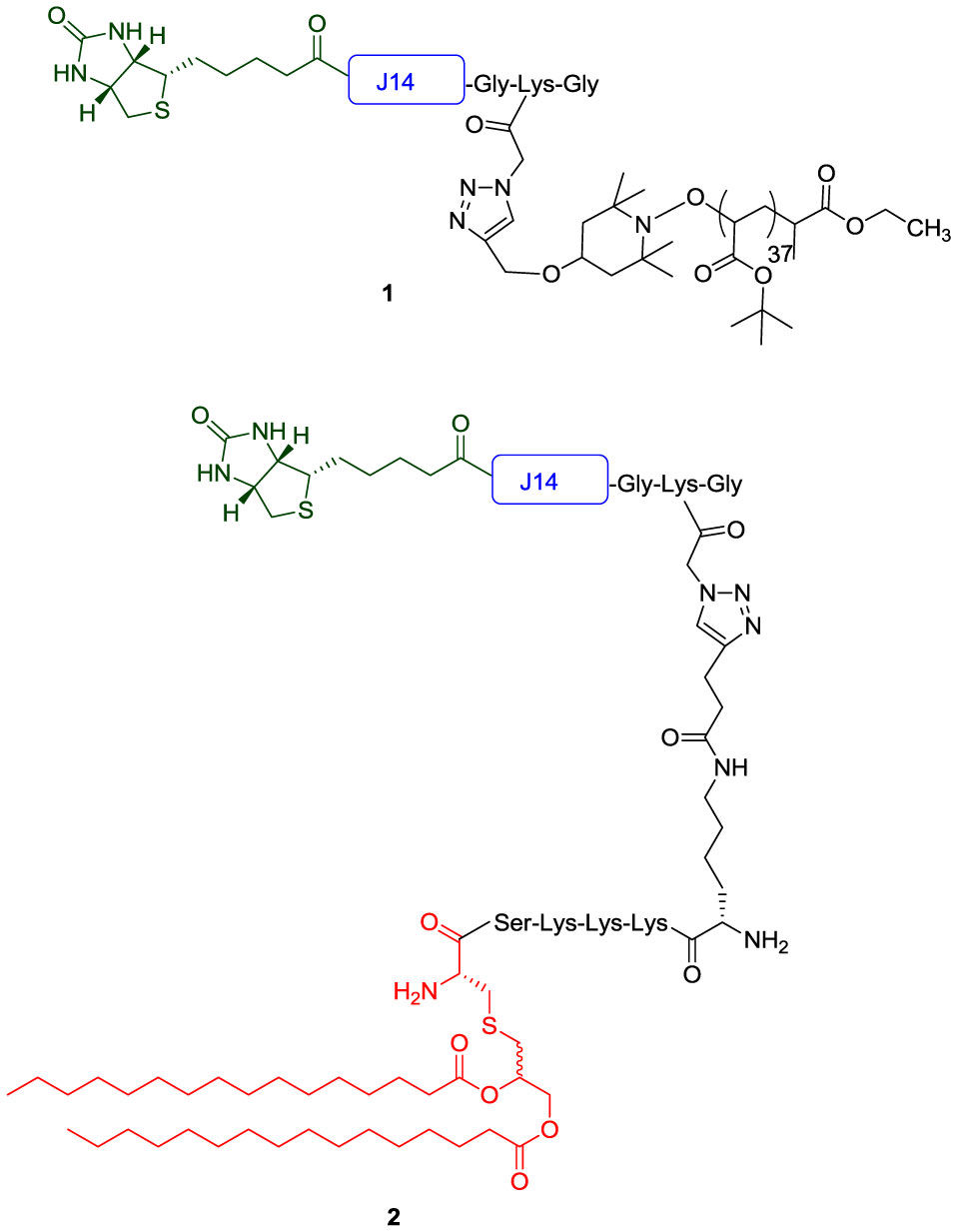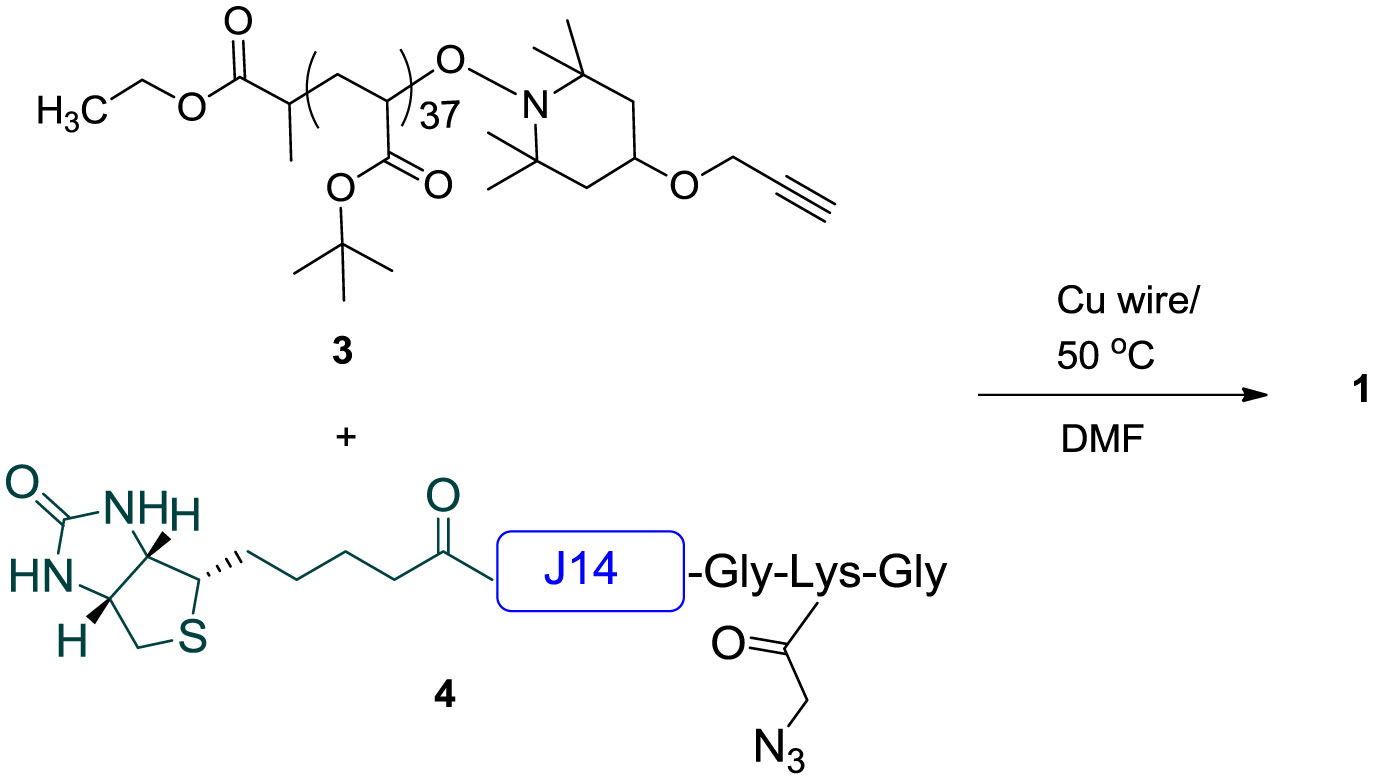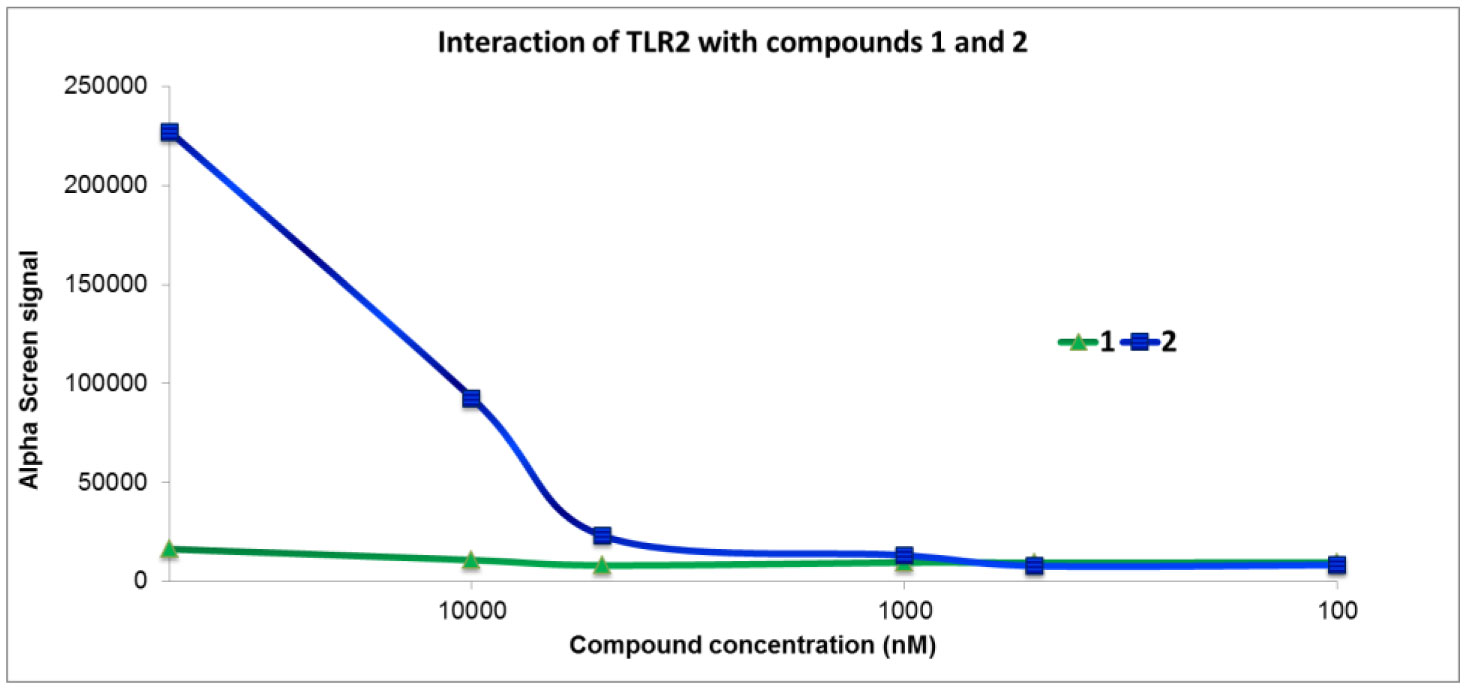Citation: Waleed M. Hussein, Phil M. Choi, Cheng Zhang, Emma Sierecki, Wayne Johnston, Zhongfan Jia, Michael J. Monteiro, Mariusz Skwarczynski, Yann Gambin, Istvan Toth. Investigating the affinity of poly tert-butyl acrylate toward Toll-Like Receptor 2[J]. AIMS Allergy and Immunology, 2018, 2(3): 141-147. doi: 10.3934/Allergy.2018.3.141
| [1] | Manal Alkan, Fadel Sayes, Abdulraouf Ramadan, Francois Machavoine, Michel Dy, Elke Schneider, Nathalie Thieblemont . Basophil activation through TLR2 and TLR4 signaling pathways. AIMS Allergy and Immunology, 2018, 2(3): 126-140. doi: 10.3934/Allergy.2018.3.126 |
| [2] | Shancy Petsel Jacob, Chikkamenahalli Lakshminarayana Lakshmikanth, Thomas M. McIntyre, Gopal Kedihitlu Marathe . Platelet-activating factor and oxidized phosphatidylcholines do not suppress endotoxin-induced pro-inflammatory signaling among human myeloid and endothelial cells. AIMS Allergy and Immunology, 2017, 1(3): 108-123. doi: 10.3934/Allergy.2017.3.108 |
| [3] | Kuo-Ting Ho, Chih-Ping Hsia, Chien-Ning Huang, Yih-Hsin Chang, Yao Lin, Ming-Yuh Shiau . Association between resistin promoter -420C>G polymorphisms and producing ability with type 2 diabetes mellitus. AIMS Allergy and Immunology, 2017, 1(4): 181-193. doi: 10.3934/Allergy.2017.4.181 |
| [4] | Hiroto Matsuse, Tohru Yamagishi, Norio Kodaka, Chihiro Nakano, Chizu Fukushima, Yasushi Obase, Hiroshi Mukae . Therapeutic modality of plasmacytoid dendritic cells in a murine model of Aspergillus fumigatus sensitized and infected asthma. AIMS Allergy and Immunology, 2017, 1(4): 232-241. doi: 10.3934/Allergy.2017.4.232 |
| [5] | Lucie Mondoulet, Sophie Wavrin, Vincent Dioszeghy, Véronique Dhelft, Emilie Puteaux, Mélanie Ligouis, Camille Plaquet, Christophe Dupont, Pierre-Henri Benhamou . No impact of filaggrin deficiency on the efficacy of epicutaneous immunotherapy in a murine model. AIMS Allergy and Immunology, 2017, 1(1): 1-14. doi: 10.3934/Allergy.2017.1.1 |
| [6] | Sabrine Louhaichi, Mariem Salhi, Anissa Berraïes, Besma Hamdi, Jamel Ammar, Kamel Hamzaoui, Agnès Hamzaoui . Co-inhibitory receptors in female asthmatic patients: Correlation with IL-17 and IL-26. AIMS Allergy and Immunology, 2018, 2(1): 10-23. doi: 10.3934/Allergy.2018.1.10 |
| [7] | Gnagnan J. E. Ezan, Masashi Mizuno . Toll-like receptor 9 is involved in the induction of galectin-9 protein by dietary anti-allergic compound fucoidan. AIMS Allergy and Immunology, 2023, 7(1): 24-39. doi: 10.3934/Allergy.2023002 |
| [8] | Norbert O. Temajo, Neville Howard . The divergence between the virus and cellular oxidative stress as separate environmental agents that trigger autoimmunity originates from their different procedural mechanisms of activating the same molecular entity: the transcription factor NF-kappa B. AIMS Allergy and Immunology, 2017, 1(2): 50-61. doi: 10.3934/Allergy.2017.2.50 |
| [9] | Fernanda Costa Brandão Berti, Karen Brajão de Oliveira . IL-10 in cancer: Just a classical immunosuppressive factor or also an immunostimulating one?. AIMS Allergy and Immunology, 2018, 2(2): 88-97. doi: 10.3934/Allergy.2018.2.88 |
| [10] | Ling Wang, Shunbin Ning . “Toll-free” pathways for production of type I interferons. AIMS Allergy and Immunology, 2017, 1(3): 143-163. doi: 10.3934/Allergy.2017.3.143 |
Peptide-based vaccines can be used to avoid the drawbacks of conventional or protein-based vaccines. These drawbacks include toxicity, allergy and autoimmune responses triggered by immunization [1]. For example, using the whole pathogen group A streptococcus (GAS) or its membrane protein, M protein, as an antigen in vaccine development can cause rheumatic heart disease due to the similarity of the antigen and heart protein [2,3]. The use of a small M protein-derived peptide sequence, J14 epitope, as an antigen in peptide-based vaccine did not cause this autoimmune complication [4]. However, peptide alone cannot produce a strong immune response. Therefore, incorporating an immunestimulant compound, adjuvant, with the peptide is essential to obtain the desired immune response against the antigen. The toxicity and low number of available licensed adjuvants directed the attention of scientists to find new ways to overcome this problem. In our laboratory, poly tert-butyl acrylate was used for the first time as a self-adjuvanting molecule in a chemical conjugation with antigens [5]. We proved the ability of this polymer to trigger the humoral immune system to produce IgG antibodies and to activate cellular immunity through the activation of CD8+ T cells. For example, a series of poly tert-butyl acrylate-J14 vaccine candidates were able to induce strong antibody production [6,7], which were able to opsonize GAS [8]. Also, poly tert-butyl acrylate conjugated with E744-57 epitope, derived from the human papilloma virus (HPV) 16 E7 protein, displayed a high efficacy as a therapeutic vaccine to eradicate tumor cells in vivo [9,10,11,12].
Toll-like receptors (TLRs) play an important role to link the innate and adaptive immunity as the activation of these transmembrane proteins leads to stimulation of both humoral and cellular immunity [13,14,15]. TLR2 is an important receptor that can be targeted by many microbial components such as lipopeptides, lipoarabinomannans, lipomannans, glycosylphosphatidylinositol, lipoteichoic acid, and a range of proteins including lipoproteins and glycoproteins, zymosan and peptidoglycan (56-60 kDa) [16,17,18,19,20]. Mixing or direct conjugation of synthetic TLR2 agonists with antigens produced strong adjuvant activity [21,22].
Improving the capability of poly tert-butyl acrylate to elicit a stronger immune response requires well understanding of its mode of action. Poly tert-butyl acrylate 1 is similar in its hydrophobicity to TLR2 agonists such as Pam2Cys, therefore we assumed that this receptor might be involved in recognition of the polymer.
Compounds 2 [23], 3 [10], and 4 [23], were synthesized as previously reported.
A mixture of Poly tert-butyl acrylate (3) (3 mg, 0.2 µmol, 1 equiv.) and biotin-J14-azide 4 (1.97 mg, 0.4 µmol, 2 equiv.) was dissolved in DMF (1 ml), and a copper wire (60 mg) was added. The air in the reaction mixture was removed by nitrogen bubbling. The reaction mixture was covered and protected from light with aluminum foil and stirred at 50 °C under nitrogen for 4 h. The wires were filtered off from the warm solution and washed with 1 ml of DMF. Millipore endotoxin-free water (7 ml) was slowly added to the solution (0.005 ml/min). Particles formed through the self-assembly process were exhaustively dialyzed against endotoxin-free water using presoaked and rinsed dialysis bags (Pierce Snakeskin, MWCO 3K). The yield of the reaction was 1.95 mg, 25%. The final formulation was self-assembled into particles in water with diameters 300-400 nm as observed by dynamic light scattering (DLS) using a Malvern Zetasizer Nano Series with DTS software. Size was analyzed using a noninvasive backscatter system. Multiplicate measurements were performed at 25 °C with a scattering angle of 173° using disposable cuvettes and the number-average hydrodynamic particle diameter was reported.
The open reading frame (ORF) of TLR2 was obtained from the Diamantina Institute, UQ. The extracellular domain of TLR2 was expressed with mCherry fusion tag in vector pCellFree G08 [23,24]. TLR2 was expressed using the Leishmania tarentolae extract prepared as previously described [25,26]. Protein was resolved on NuPage Novex 4%-12% SDS-PAGE gel (Invitrogen, Australia) and scanned for fluorescence using the ChemiDoc MP System (Bio-Rad, Australia). Preheating gel samples to 72 °C instead of > 95 °C allows the mCherry fluorescence to persist in the SDS-Page gel, allowing expression size to be validated against the ORF size expected. TLR2 fusion protein showed its expected size (91 kDa).
The extracellular domain of TLR2 fusion protein was expressed in L. tarentolae extract at 27 °C for 30 minutes. 2.5 µl of protein expression reaction was then mixed with an equal volume of serially diluted biotin-labeled compound 1 ranging from 100 nM to 50 µM. Expression reaction refers to the Leishmania tarentolae cell-free protein synthesis reaction, which expresses the TLR fusion protein. Then, protein expression was continued by incubation at 27 °C for an additional 2.5 hours. The resulting mixture was diluted 4 fold in buffer A (25 mM HEPES, 5 mM NaCl), followed by 3 more 10-fold dilutions in buffer A. From each dilution, 2 µl was added to 12.5 µl of buffer B (0.32 µg/µl anti-cMyc acceptor beads, 25 mM HEPES, 50 mM NaCl, 0.001% (v/v) casein and 0.001% (v/v) Nonidet P-40), and incubated in the dark for 45 min to allow acceptor beads to couple with cMyc-tagged fusion protein. Subsequently, 0.4 µg of Streptavidin-coated donor beads in 2 µl of buffer A was then added to each dilution and incubated for 45 min in the dark. The AlphaScreen signal was measured with the Envision Multilabel plate reader (Perkin Elmer, Australia) according to the manufacturer's recommended settings (excitation: 680/30 nm for 0.18 s, emission: 570/100 nm after 37 ms). For each concentration of compound 1, the maximal AlphaScreen signal was determined and plotted against the sample dilution.
Here, we performed the first attempt to investigate the ability of poly tert-butyl acrylate to bind with TLR2 via the AlphaScreen assay and cell-free expression techniques. Pam2Cys is a potent TLR2 agonist that was used both in vitro and in vivo as a self adjuvanting moiety [27,28]. In this study, Pam2Cys was used as a positive control. Polymer 1 and its Pam2Cys analogue 2 were tagged with a biotin moiety (Figure 1). For the attachment of the polymer 3 to J14 epitope, the azide derivative of biotin-J14 (4-biotin-KQAEDKVKASREAKKQVEKALEQLEDKVKGK(OCCH2N3)G) was synthesized by using solid phase peptide synthesis (SPPS) [23]. Compound 4 was then conjugated with the alkyne group on polymer 3 via the copper-catalyzed azide-alkyne cycloaddition (CuAAC) reaction to give the final compound 1 in 25% yield (Figure 2). The particle size diameter, 300-400 nm, of the final formulation after self-assembly in water was measured by dynamic light scattering (DLS).
 Figure 1. Structures of poly tert-butyl acrylate-J14-biotin (1) and Pam2Cys-J14-biotin (2).
Figure 1. Structures of poly tert-butyl acrylate-J14-biotin (1) and Pam2Cys-J14-biotin (2).The AlphaScreen assay was performed to test the affinity of compounds 1 and 2 toward the in vitro cell-free expressed extracellular domain of TLR2 [23]. The biotin tagged compounds 1 and 2 were bound to a streptavidin-coated donor bead. Anti-cMyc acceptor beads recruited the TLR2 through its cMyc tag. Upon excitation, the donor bead generated singlet oxygen with a half-life of 4 µs and diffusive distance of ∼200 nm. Interaction of the compounds (1 and 2) with TLR2 brought donor and acceptor beads into close proximity, which allowed the singlet oxygen to react with thioxene derivatives of the acceptor beads. This is turn stimulates luminescence which is detected as an AlphaScreen signal in counts per second (cps). As expected, the Pam2Cys analogue bound to TLR2 (Figure 3). In contrast, polymer 1 did not show any affinity to bind to TLR2 (Figure 3). This demonstrated that the ability of conjugate 1 to stimulate an immune response occurs through a different mechanism rather than binding to TLR2.
Finding the mode of action of poly tert-butyl acrylate may help in modulating the immunogenic activity of the polymer. Two biotin conjugates 1 and 2 were successfully designed and synthesized to investigate the affinity of poly tert-butyl acrylate toward TLR2. The extracellular domain of TLR2 was successfully expressed by using the cell-free expression technique. The well-known TLR2 agonist Pam2Cys 2 demonstrated a very strong binding to TLR2; however, the polymer analogue 1 did not show any affinity by applying the AlphaScreen assay. Discovery of the mechanism of action of poly tert-butyl acrylate is still under progress.
 Figure 2. Synthesis of 1 through CuAAc reaction between the alkyne derivative of poly tert-butyl acrylate (3) and azide derivative of J14-biotin (4) in presence of copper wire and DMF at 50 °C.
Figure 2. Synthesis of 1 through CuAAc reaction between the alkyne derivative of poly tert-butyl acrylate (3) and azide derivative of J14-biotin (4) in presence of copper wire and DMF at 50 °C. Figure 3. Analysis of interactions of conjugates 1 and 2 with in vitro expressed TLR2 using the AlphaScreen proximity assay. The AlphaScreen assay was performed at 10 nM concentration of cell-free expressed TLR2, while varying the concentrations (100 nM-50 µM) of 1 or 2.
Figure 3. Analysis of interactions of conjugates 1 and 2 with in vitro expressed TLR2 using the AlphaScreen proximity assay. The AlphaScreen assay was performed at 10 nM concentration of cell-free expressed TLR2, while varying the concentrations (100 nM-50 µM) of 1 or 2.This work was funded by the National Health and Medical Research Council [NHMRC Program Grant 1132975].
All authors declare that they have no conflict of interest in this paper.
| [1] |
Purcell AW, McCluskey J, Rossjohn J (2007) More than one reason to rethink the use of peptides in vaccine design. Nat Rev Drug Discov 6: 404–414. doi: 10.1038/nrd2224

|
| [2] |
Pruksakorn S, Currie B, Brandt E, et al. (1994) Identification of T-cell autoepitopes that cross-react with the C-terminal segment of the M-protein of group-a streptococci. Int Immunol 6: 1235–1244. doi: 10.1093/intimm/6.8.1235

|
| [3] | Kotb M, Courtney HS, Dale JB, et al. (1989) Cellular and biochemical responses of human Lymphocytes-T stimulated with streptococcal-m proteins. J Immunol 142: 966–970. |
| [4] |
Hayman WA, Brandt ER, Relf WA, et al. (1997) Mapping the minimal murine T cell and B cell epitopes within a peptide vaccine candidate from the conserved region of the M protein of group A streptococcus. Int Immunol 9: 1723–1733. doi: 10.1093/intimm/9.11.1723

|
| [5] |
Skwarczynski M, Zaman M, Urbani CN, et al. (2010) Polyacrylate dendrimer nanoparticles: a self-adjuvanting vaccine delivery system. Angew Chem Int Edit 49: 5742–5745. doi: 10.1002/anie.201002221

|
| [6] |
Ahmad FAA, Jia Z, Zaman M, et al. (2014) Polymer-peptide hybrids as a highly immunogenic single-dose nanovaccine. Nanomedicine 9: 35–43. doi: 10.2217/nnm.13.7

|
| [7] |
Chandrudu S, Bartlett S, Khalil ZG, et al. (2016) Linear and branched polyacrylates as a delivery platform for peptide-based vaccines. Ther Deliv 7: 601–609. doi: 10.4155/tde-2016-0037

|
| [8] |
Zaman M, Skwarczynski M, Malcolm JM, et al. (2011) Self-adjuvanting polyacrylic nanoparticulate delivery system for group A streptococcus (GAS) vaccine. Nanomed-Nanotechnol 7: 168–173. doi: 10.1016/j.nano.2010.10.002

|
| [9] |
Hussein WM, Liu TY, Jia Z, et al. (2016) Multiantigenic peptide-polymer conjugates as therapeutic vaccines against cervical cancer. Bioorgan Med Chem 24: 4372–4380. doi: 10.1016/j.bmc.2016.07.036

|
| [10] |
Liu TY, Hussein WM, Giddam AK, et al. (2015) Polyacrylate-based delivery system for self-adjuvanting anticancer peptide vaccine. J Med Chem 58: 888–896. doi: 10.1021/jm501514h

|
| [11] |
Liu TY, Hussein WM, Jia Z, et al. (2013) Self-adjuvanting polymer-peptide conjugates as therapeutic vaccine candidates against cervical cancer. Biomacromolecules 14: 2798–2806. doi: 10.1021/bm400626w

|
| [12] |
Liu TY, Giddam AK, Hussein WM, et al. (2015) Self-adjuvanting therapeutic peptide-based vaccine induce cd8(+) cytotoxic t lymphocyte responses in a murine human papillomavirus tumor model. Curr Drug Deliv 12: 3–8. doi: 10.2174/1567201811666141001155729

|
| [13] |
Akira S, Takeda K, Kaisho T (2001) Toll-like receptors: critical proteins linking innate and acquired immunity. Nat Immunol 2: 675–680. doi: 10.1038/90609

|
| [14] |
Akira S, Uematsu S, Takeuchi O (2006) Pathogen recognition and innate immunity. Cell 124: 783–801. doi: 10.1016/j.cell.2006.02.015

|
| [15] |
Iwasaki A, Medzhitov R (2004) Toll-like receptor control of the adaptive immune responses. Nat Immunol 5: 987–995. doi: 10.1038/ni1112

|
| [16] |
Skwarczynski M, Dougall AM, Khoshnejad M, et al. (2012) Peptide-based subunit vaccine against hookworm infection. PLoS One 7: e46870. doi: 10.1371/journal.pone.0046870

|
| [17] |
Abdel-Aal ABM, Al-Isae K, Zaman M, et al. (2011) Simple synthetic toll-like receptor 2 ligands. Bioorg Med Chem Lett 21: 5863–5865. doi: 10.1016/j.bmcl.2011.07.102

|
| [18] |
Abdel-Aal ABM, El-Naggar D, Zaman M, et al. (2012) Design of fully synthetic, self-adjuvanting vaccine incorporating the tumor-associated carbohydrate tn antigen and lipoamino acid-based Toll-like Receptor 2 ligand. J Med Chem 55: 6968–6974. doi: 10.1021/jm300822g

|
| [19] |
Miyake K (2007) Innate immune sensing of pathogens and danger signals by cell surface Toll-like receptors. Semin Immunol 19: 3–10. doi: 10.1016/j.smim.2006.12.002

|
| [20] |
Tapping RI (2009) Innate immune sensing and activation of cell surface Toll-like receptors. Semin Immunol 21: 175–184. doi: 10.1016/j.smim.2009.05.003

|
| [21] |
Moyle PM, Toth I (2008) Self-adjuvanting lipopeptide vaccines. Curr Med Chem 15: 506–516. doi: 10.2174/092986708783503249

|
| [22] |
Eriksson EM, Jackson DC (2007) Recent advances with TLR2-targeting lipopeptide-based vaccines. Curr Protein Pept Sci 8: 412–417. doi: 10.2174/138920307781369436

|
| [23] | Hussein WM, Choi PM, Zhang C, et al. (2017) Evaluation of lipopeptides as Toll-like Receptor 2 Ligands. Curr Drug Deliv 14: 935–943. |
| [24] |
Gagoski D, Mureev S, Giles N, et al. (2015) Gateway-compatible vectors for high-throughput protein expression in pro- and eukaryotic cell-free systems. J Biotechnol 195: 1–7. doi: 10.1016/j.jbiotec.2014.12.006

|
| [25] |
Kovtun O, Mureev S, Jung W, et al. (2011) Leishmania cell-free protein expression system. Methods 55: 58–64. doi: 10.1016/j.ymeth.2011.06.006

|
| [26] |
Mureev S, Kovtun O, Nguyen UTT, et al. (2009) Species-independent translational leaders facilitate cell-free expression. Nat Biotechnol 27: 747–752. doi: 10.1038/nbt.1556

|
| [27] |
Tan ACL, Mifsud EJ, Zeng WG, et al. (2012) Intranasal administration of the TLR2 agonist Pam2Cys provides rapid protection against influenza in mice. Mol Pharm 9: 2710–2718. doi: 10.1021/mp300257x

|
| [28] |
Zeng WG, Eriksson E, Chua B, et al. (2010) Structural requirement for the agonist activity of the TLR2 ligand Pam2Cys. Amino Acids 39: 471–480. doi: 10.1007/s00726-009-0463-0

|
| 1. | Mengmeng Zhou, Yutong Bi, Haijun Zhou, Xiaoqi Chen, Fen Zhang, Yantao Li, Xiongwei Qu, Aggregation Behavior of Poly(Acrylic acid‐co‐Octadecyl Methacrylate) and Bovine Serum Albumin in Aqueous Solutions, 2021, 10, 2191-1363, 373, 10.1002/open.202000336 | |
| 2. | Reshma J. Nevagi, Mariusz Skwarczynski, Istvan Toth, Polymers for subunit vaccine delivery, 2019, 114, 00143057, 397, 10.1016/j.eurpolymj.2019.03.009 | |
| 3. | Mengmeng Zhou, Yutong Bi, Chengyu Li, Xiaoqi Chen, Fen Zhang, Haijun Zhou, Jijun Xiao, Yantao Li, Xiongwei Qu, Preparation of polyacrylate/nanoemulsion composites and their adjuvant activity with OVA as the model antigen, 2021, 207, 09277765, 112015, 10.1016/j.colsurfb.2021.112015 | |
| 4. | Jiahui Zhang, Jingyi Fan, Mariusz Skwarczynski, Rachel J Stephenson, Istvan Toth, Waleed M Hussein, Peptide-Based Nanovaccines in the Treatment of Cervical Cancer: A Review of Recent Advances, 2022, Volume 17, 1178-2013, 869, 10.2147/IJN.S269986 | |
| 5. | Chengyu Li, Yutong Bi, Mengmeng Zhou, Lu Bai, Xiaoqi Chen, Jijun Xiao, Fen Zhang, Haijun Zhou, Yantao Li, Preparation and Evaluation of Polyacrylate Microgels and Their Adjuvant Activities Using Ovalbumin as a Model Antigen, 2023, 12, 2191-1363, 10.1002/open.202200246 |